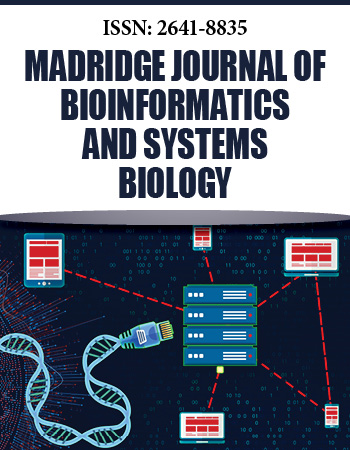Research Article
Color Blindness Correction using Augmented Reality
1Department of Computer Science and Systems Engineering, Sree Vidyanikethan Engineering College, Tirupati, Andhra Pradesh, India
2Department of Software Engineering, SRM Institute of Science and Technology, Kattankulathur, Tamil Nadu, India
*Corresponding author: Sasikumar Gurumurthy, Professor, Department of Computer Science and Systems Engineering, Sree Vidyanikethan Engineering College, Tirupati, Andhra Pradesh, India, Tel: 8870919338, E-mail: mithrangurugsk@gmail.com
Received: February 28, 2019 Accepted: April 12, 2019 Published: April 22, 2019
Citation: Gurumurthy S, Rajagopal RD, AjayAshar A. Color Blindness Correction using Augmented Reality. Madridge J Bioinform Syst Biol. 2019; 1(2): 31-33. doi: 10.18689/mjbsb-1000106
Copyright: © 2019 The Author(s). This work is licensed under a Creative Commons Attribution 4.0 International License, which permits unrestricted use, distribution, and reproduction in any medium, provided the original work is properly cited.
Abstract
To alter the hue of an image in real-time to correct color blindness using a mobile application.
Keywords: Augmented Reality; Colors; Hue shifts; Realtime.
Introduction
Augmented Reality provides a real-time world environment and allows the viewers to interact with game live. This happens with the help of various augmented factors such as audio, visual, computer graphics and even global positioning input. Augmented reality synchronizes the environment with the graphical structure to provide an ultimate virtual reality gaming experience.
Using the same technology, we can alter the saturation of an image in real time to print the correct color that can be perceived as it is by a colorblind person
Method and Procedures
The color correction application is built for an android device using Unity 2017.3.0f 3. Unity allows the developers to build different games, scenes, environments, augmented reality scenes, virtual reality scenes, etc. Vuforia package is used to access the augmented reality camera. Vuforia augmented reality is configured in the environment [1].
There exists a hierarchy in the Unity environment where the game objects are visible. The hierarchy of the Unity environment includes an Augmented Reality camera, and a canvas, that embeds the user interface components (Figure 1).
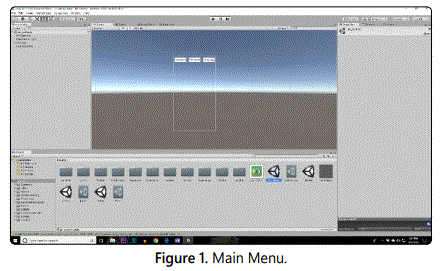
User interface components include three buttons that loads filters for the three opias (Deuteranopia, Protanopia and Tritanopia) (Figures 2-4). Each button, on clicking changes the scene. Each scene has different color filters and the scene includes additional sliders to twitch the hue within the set range [2].
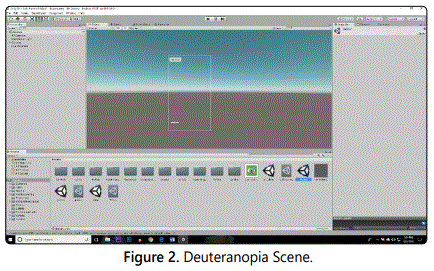
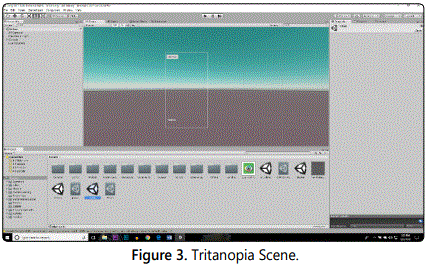
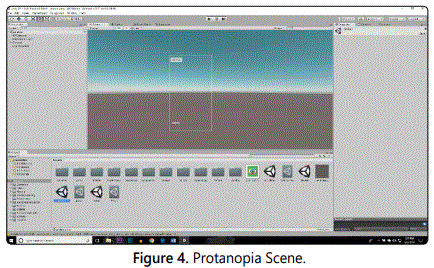
The application hosts a post processing utility tool that is available on Unity asset store. The post processing utility tool is an additional package that gives us full control to adjust the graphics of any scene in unity. Some of its attributes are color grading, anti-aliasing, chromatic aberration, motion blur, and many others.
Hue shift is an attribute of color grading [3]. A post processing profile is created. Also, an additional script is created that loads the created post processing profile to access the color grading component.
The sliders on canvas (for individual scene) control the hue. The additional script created to control the post processing profile is linked with the sliders that give us the control to change hue on the user interface (Figure 5).

All the scripts are embedded in to the AR Camera game oject [4]. The sliders are linked with the script that fetches the hue from the post processing utility tool. Initial hue levels are set and a range is calculated for the sliders (after testing).
Testing and Analysis
Unit testing is shown in table 1 and integration testing is shown in table 2.
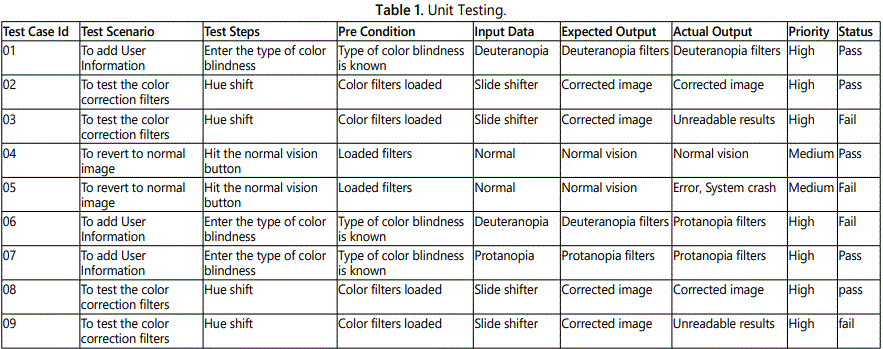


Results and Discussion
A. Preliminary test
The Ishihara plates were shown to both sets of test subjects. The numbers inside the plates (7, 10, 4, 2, 8 and 45) are not visible to any of the four red-green color-blind subjects whereas all four normal vision subjects could correctly identify all six values [5]. The designing and testing of various filters and image enhancement techniques were used on the images. As a simple approach, the images were processed to remove the green and blue components leaving only the red component. This can be done shifting the hue.
B. Test results post execution of the application
Once the application was running on the device, the Ishihara plates were shown again to the test subjects. The normal vision subjects could identify the numbers on the plates [6]. Using the app, the color-blind subjects were also able to identify the numbers on the Ishihara plates and hence cleared the test.
Conclusion
Color vision deficiency is a very common disease in todayʼs world, yet there are no specific corrective measures for the same. This paper suggests one method to correct color-blindness. By shifting the hue of a real-time image, the colors can be inspected, and perceived by a color-blind individual.
Acknowledgment
The author would like to thank Mrs. Renuka Devi for her guidance throughout the development of the application.
References
- Mellilo P, Riccio D, Di Perna L, et al. Wearable Improved vision system for color vision deficiency correction. IEEE Journal of Translational Engineering in Health and Medicine. 2017; 5: 1-7. doi: 10.1109/JTEHM.2017.2679746
- Badeche M, Benmohamed M. Real-time tracking for Augmented reality. International Conference on Information & Communication Technologies. 2006: 1773-1778. doi: 10.1109/ICTTA.2006.1684654
- Agusanto K, Li L, Chuangui Z, Sing NW. Photorealistic rendering for augmented reality using environment illumination. The Second IEEE and ACM International Symposium on Mixed and Augmented Reality. 2003: 208-216. doi: 10.1109/ISMAR.2003.1240704
- Poret S, Dony RD, Gregori S. Image processing for color blindness correction. IEEE Toronto International Conference Science and Technology for Humanity (TIC-STH). 2009: 539-544. doi: 10.1109/TIC-STH.2009.5444442
- Halic FT, Kockara SS, Bayrak TC, Iqbal FK, Rowe FR. Two-way SemiAutomatic Registration in Augmented Reality System. IEEE International Conference on Systems, Man and Cybernetics. 2007: 3390-3395. doi: 10.1109/ICSMC.2007.4414000
- Bostanci E, Clark AF, Kanwal N. Vision-based User Tracking for Outdoor Augmented Reality. IEEE Symposium on Computers and Communications (ISCC). 2012: 000566-000568. doi: 10.1109/ISCC.2012.6249356

